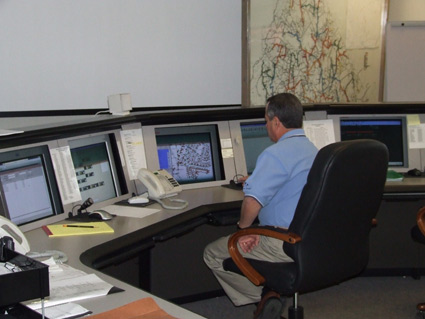
Distribution Dispatcher or System Operator?
The march of technology has led to improved but complex distribution operating systems. The challenge is to train employees to operate these systems and to understand how they interface with field operations and employee safety.

By Pam Tompkins, CSP, CUSA
Information technology has profoundly transformed the electric distribution dispatching center. Historically, a dispatching center’s primary responsibility was to receive outage calls, assign daily work and communicate to field crews via the company radio.
The days of receiving outage calls and searching for sectionalizing devices on a paper mapping system, however, have been replaced by computer based technology. Supervisory Control and Data Acquisition (SCADA), Outage Management Systems (OMS), and Integrated Voice Response (IVR) and other systems have improved reliability, outage response time, and outage restoration time and employee safety.
These operating systems, integrated with GIS (Geographic Information Systems) mapping systems, CIS (Customer Information Systems) and AVL (Automatic Vehicle Location) systems, can provide a real time “snapshot” of the distribution system, immediate up-to-date customer information, predict the exact outage and track vehicles.
Training challenges
With the design and implementation of these complex distribution operating systems, some utilities have faced the challenge of training employees, not only to operate and monitor these systems but also to understand how they interface with field operations and employee safety. Additionally, electric utilities operating facilities that could have an impact on the national grid have national training requirements for operators to ensure the reliability of the bulk power system in North America. This leaves small- to medium-sized distribution utilities with no clear standard on the best training methodology to meet safety and reliability concerns.
Identifying employee training needs may be difficult for utilities that have benchmarked dispatchers on the number of phone calls answered or dropped instead of their knowledge and demonstrated ability to operate and “oversee” the power system. The challenge of training utility personnel, who still operate with a “radio room” concept, to operate and maintain a distribution system is complex.
This requires a management commitment to transition employees from a “dispatcher” to a System Operator (Controller). The utility may find the job qualifications of a person who has worked well in a dispatcher position may not be exactly the qualifications needed for the System Operator position. Operational field employees must have confidence that they are communicating with System Operators who understand operating systems and employee work procedures to ensure safety and system reliability.
Addressing standards
The National Electric Safety Code (NESC) and OSHA electrical standards address certain requirements for System Operators. These requirements mainly refer to switching control procedures for a “Designated Person”. OSHA refers to this designated person as the “System Operator”. NESC requires a “Designated Person” to keep informed of operating conditions affecting the safe and reliable operation of the power system, to maintain a suitable record of the operating changes made on the system and to issue or deny authorization for switching to ensure safe and reliable operations.
The code addresses further requirements for the “Designated Person” under Section 444 – De-energizing equipment or lines to protect employees. This section addresses tagging and recordkeeping. Operating systems must provide an accurate method of documenting tagging and system changes to provide field employees with the essential information necessary to perform their jobs.
Developing a plan
Prior to the start of training development, a thorough review of the System Operator job description should be performed to ensure all job functions have been identified. Next, the tasks required for each job function should be identified and a structured plan developed to ensure operators are trained to perform each task.
Tasks could have multiple layers of required training to ensure the operator has a good foundation and thorough knowledge. System Operators must understand how the technical systems in the office relate to field equipment and to employees working on this equipment. As an example, a System Operator may use an OMS system to model a planned switching order. In doing this, the System Operator needs to understand how switching could affect employee safety and system reliability and have a good understanding of the required job tasks for field employees to complete the job. To gain system knowledge, a structured process should be developed to ensure academics; hard skills and on-the-job training meet the job requirements. System Operators need to understand operating systems, line design, system coordination, equipment operation, field operations relating to line construction and maintenance, switching operations and many other utility specific requirements. Possible sources for academic knowledge may be through correspondence courses, such as Northwest Lineman College, or local technical colleges offering electrical technology courses.
Hands-on
Hard skills includes specific training from SCADA, OMS and other operating system vendors and equipment training courses, such as regulator training and others offered through a statewide cooperative or municipal program or a technical college. Another source of equipment training would come from the manufacturers of the equipment through seminars and “hands on” training.
On-the-job training should merge the learned academics and hard skills to work performed in the field. Observing field employees perform tasks such as installing and operating regulators can augment the tasks the System Operator must learn, such as operating OMS. The final process should include a written and a practical review designed to ensure operators have the knowledge required to operate and monitor the electrical system.
Although System Operator training development, implementation and maintenance is not an easy task, the end result will certainly ensure System Operators are well trained to make reasonable decisions to enhance employee safety and system reliability.
About the Author: Pam Tompkins, a Certified Safety Professional and Certified Utility Safety Administrator, is President of SET Solutions in Lexington, South Carolina. The company specializes in helping small to medium size electric utilities comply with safety and training requirements. Prior to forming SET in 2000, Tompkins worked in the electric utility industry for over 20 years.
Article Previously Published in the January-February 2009 Issue of Incident Prevention Magazine.